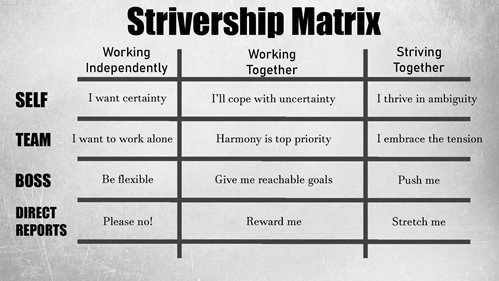
Thriving In Ambiguity: Part 3 of 5 – Relationship to Team
Ambiguity: a state of being vague and unclear.
The Coronavirus Pandemic has forced businesses to confront a world of ambiguity. We are in uncharted territory. When will things to return to normal? And what will ‘normal’ look like? I help leaders thrive in ambiguity during the best of times. Our economy was disruptive before the onset of the pandemic. Now the sense of uncertainty has been taken to another level.
The best companies thrive in ambiguity because they are led by people who imbue a spirit of Strivership, an ethic of continuous improvement based on the origin of compete: to strive together. Today’s definition, ‘to outdo,’ narrows and distorts the meaning which is why people fear competing. It is viewed as a zero-sum endeavor where one is destroyed and the other is victorious. That‘s cutthroat, not competing. Ultimately, true competitors view competing as striving together – an opportunity to make each other better. Striving together is not always about winners and losers. It’s about becoming immersed in the process of getting better by getting out of your comfort zone to wrestle with difficult problems. You cannot control winning, but you can control your willingness to compete.
Leaders imbue Strivership by cultivating key attributes in four relationships: Relationship to Self, Team, Boss, and Direct Reports. In part 2, I discussed Relationship to Self, the conversation you have with yourself when challenged to move out of your comfort zone. When an individual decides to take on a challenge that offers no assurance of success, that individual is leading by example. Now let’s take a look at the Strivership Matrix again, and discuss leading by example in Relationship to Team.
People who prefer Working Independently do not function well in a team setting. It takes them too far out of their comfort zone. They crave the certainty that comes with the opportunity to work alone.
People who settle for Working Together – collaborating – struggle on teams that operate in rapid change environments. Collaboration worked perfectly during the Industrial Revolution when companies focused on the mass production of large quantities of standardized products. In this kind of linear, task-oriented work environment, it made perfect sense to recruit people who were good fits. Achieving and maintaining harmony on teams was a top priority.
Unfortunately companies are still searching for people who fit, despite the fact that the economy no longer operates in “rinse and repeat” mode. The key to success in a 21st century economy is productivity, not efficiency. Product cycles have shrunk dramatically. As the saying goes: “Last year’s products are last year’s dollars.” In this disruptive environment where workers must be in constant invent-adapt-reinvent mode, companies must begin searching for people who stand out – people who are willing to Strive Together.
Members of teams that strives together assert themselves by challenging their teammates in meetings – and they are willing to be pushed in return. They understand that by holding back to protect their brand they would be robbing their team of learning. However, when they leave a meeting, everything that happened in the meeting room stays in the meeting room. They support their teammates to everyone outside the team unconditionally – no exceptions. Internally they support each other as well and one of the most important ways they demonstrate their support is to communicate directly with a teammate whenever a serious issue arises. In companies that embrace Strivership, triangulation is a disease that compromises the sanctity of the team relationship.
People who embrace the tension that comes with striving together prioritize respect over like. When I had teams where getting along was the #1 goal, we always underachieved. When I had teams where respect was valued over having to like each other, we almost always overachieved. When achieving harmony is prioritized the respect factor never truly catches up. When people demonstrate respect for teammates that they do not like and that respect is reciprocal both parties the like factor eventually catches up. This display of empathy results in the creation of a powerful bond that is far stronger than any social bond.
Abraham Lincoln understood this dynamic intuitively, as evidenced by the selection of his cabinet. Pulitzer prize-winning historian Doris Kearns Goodwin wrote an entire book on this subject titled, Team of Rivals. The book examines how Lincoln brought his most vocal and ardent political rivals into his cabinet, and how this impacted his presidency. Lincoln’s ability to embrace this tension enabled his team to strive together to lead our nation through its most dire test. To tackle the seemingly intractable problems facing the country, Lincoln could not afford to put together a group of people who simply fit together nicely. He needed to assemble a team of people who stood out for their expertise.
In Lincoln’s cabinet, relationships were built on respect. This became clear when upon Lincoln’s passing, his Secretary of War, Edward Stanton, once a bitter adversary, said: “Now he belongs to the ages.”
Next time: We will discuss what it means to lead by example in Relationship To Boss.
View Jeff’s entire series here.
Allied Partner Jeff Moore is well-kn own and highly-respected throughout college athletics – not only for what he accomplished as a coach, but also for his prowess and the tangible results he has delivered while working with teams and athletic departments. As CEO of Moore Leadership, Jeff helps leaders in both college sports and the corporate world build championship teams.
own and highly-respected throughout college athletics – not only for what he accomplished as a coach, but also for his prowess and the tangible results he has delivered while working with teams and athletic departments. As CEO of Moore Leadership, Jeff helps leaders in both college sports and the corporate world build championship teams.



